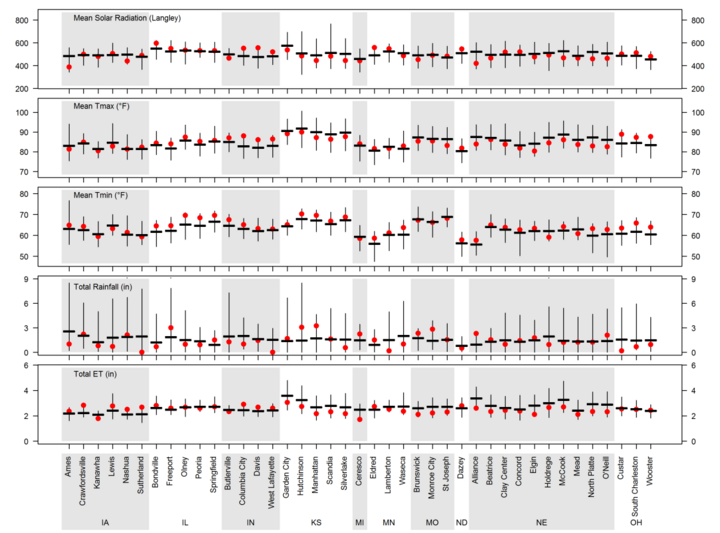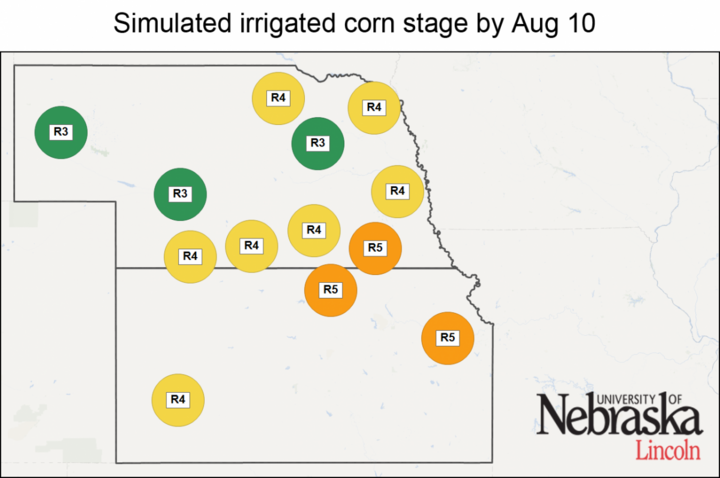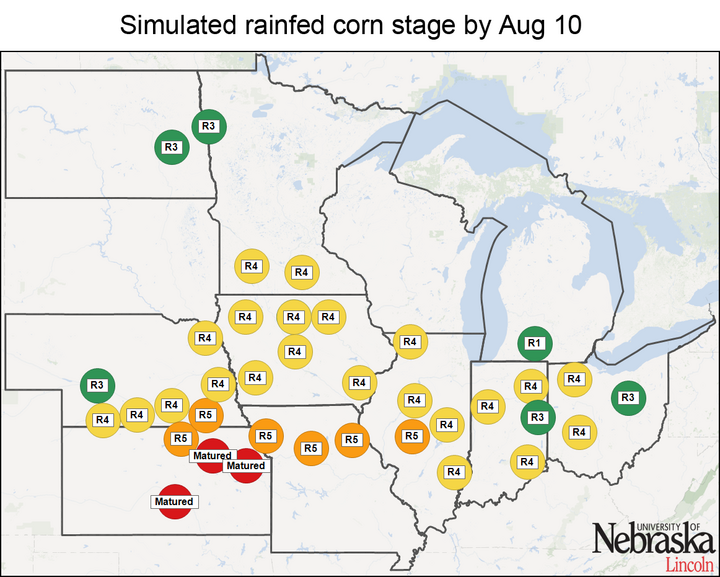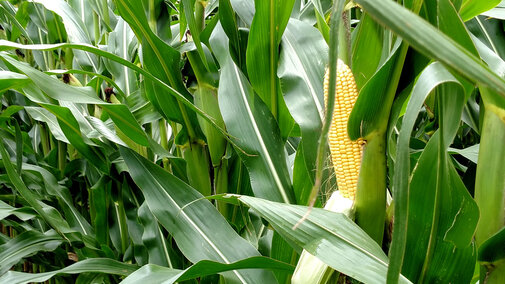To evaluate, in “real-time,” the impact of this season’s weather on corn yield potential and its spatial variability across the Corn Belt, simulations of 2016 end-of-season corn yield potential and real-time crop stage were performed for 41 locations. The simulations were developed using the UNL Hybrid-Maize model in collaboration with faculty and extension educators from 10 universities.
This is the third article in a series summarizing simulated crop stages and yield forecasts across a wide area of the Corn Belt. Data for the Aug. 10 corn yield forecasts is available. Previous corn yield forecasts for this year can be found here. Details on Hybrid-Maize and the underpinning methodology to forecast end-of-season yields, as well as on interpretation and uses of yield forecasts, is described in a previous article.
The season continued with near average temperatures during early August, except for Nebraska and Kansas (low daytime temperatures) and Illinois, Indiana, and Ohio (high daytime and nighttime temperatures). Rainfall was highly variable across locations, with below-normal rainfall in Indiana, Ohio, southern Minnesota, and parts of Iowa. A summary of weather conditions during the last two weeks is shown in Figure 1.

Figure 1. Daily solar radiation, maximum and minimum air temperature (Tmax and Tmin), total rainfall, and total reference grass-based evapotranspiration (ET) for the July 27 - Aug 10 period. Vertical bars indicate the range for these variables based on 20+ years of weather records. The horizontal thick line indicates the long-term average and the red dots indicate 2016 values.
Simulated Corn Stage Across 41 Locations
Grain filling is in full swing throughout Nebraska and the Corn Belt and physiological maturity (black layer) has been reached at some of the southern rainfed sites in Kansas (Figure 2). Corn is still behind average development at a few locations in the northern Corn Belt, including eastern North Dakota, northern Minnesota, and southern Michigan.

Figure 2. Simulated crop development stage for irrigated and rainfed corn at each location. Vn: vegetative stage (nth leaf); R1: silking; R2: blister; R3: milk; R4: dough; R5: dent; and matured (“black layer”).

Irrigated Corn: High Probability of Near- Or Above-Average Yields
The range of forecasted irrigated corn yields for each location, as well as the probabilities for yields above, near, or below average, are shown in Figures 3 and 4. All irrigated sites exhibited a very low probability (75%) of near-average yields. Weather conditions during the rest of the season will determine if the other half of the irrigated sites will also remain near-average yield or achieve above-average yield.

Figure 4. Probability of obtaining a 2016 yield below (≤10%, red color), near (±10%, yellow color), and above (>10%, green color) the long-term (2005-2014) average at each location. The larger a color section is within the pie chart, the higher the probability that corn yield will be in that category.

Rainfed Corn: Highly Uncertain and Variable Yield Across Locations
Forecasted yields look highly variable across rainfed sites (Figures 3 and 4). The scenario looks certain for about half of the sites. There is a relatively high probability (>75%) of above-average yield at seven of the 37 rainfed locations: western Nebraska (North Platte), central-east and southeastern Iowa, and northwestern Missouri (Mead, Lewis, and St Joseph), eastern North Dakota and northern Minnesota (Dazey and Eldred), and central Illionois (Peoria). Likewise, there is a high probability (>75%) of near-average yields at eight of the 37 sites, located mainly in the southern fringe of the Corn Belt. Finally, there is a high-probability (>75%) of below-average yield at only three sites: southeastern Nebraska (Beatrice) and northwestern and southeastern Iowa (Crawfordsville and Sutherland). Similarly, the yield scenario does not look promising for three other Nebraska sites (McCook, Clay Center, and Concord) and central Iowa (Ames). Near- or above-average yields are expected for the other half of the rainfed sites, except for the eastern fringe of the Corn Belt (Ohio, eastern Indiana, and Michigan) where there is still a substantial probability of below-average yields if weather conditions are unfavorable during the rest of the season.
Conclusions
In general, forecasted yields followed the trends observed in the July 27 yield forecasts. Growing conditions indicate a high probability of near-average yields at half of the irrigated sites. Forecasted yields look highly variable across locations, falling into above (19% of sites), near (22% of sites), or below-average (8% of sites, with another 11% with highly unfavorable yield scenario) categories across. The yield scenario is still uncertain for the other half of the rainfed sites, although near- or above-average yields are likely except for the eastern fringe of the Corn Belt where there is still a substantial probability of below-average yield.
These forecasts do not take into consideration problems with stand emergence, hail/flooding damage, replanting situations, disease, or nitrate leaching. In fields negatively affected by these constraints, actual yields will be lower than estimates provided here. It is important to keep in mind that yield forecasts are not field specific and, instead, represent an estimate of average on-farm yield for a given location and surrounding area in absence of the yield-reducing factors mentioned here. Likewise, crop development stages and forecasted yields will deviate from the ones reported here in fields with planting dates or hybrid maturities that differ markedly from the ones used as the basis. We will follow up with further forecasts in late August.
For more information about these yield forecasts, contact Patricio Grassini at pgrassini2@unl.edu or call 402-472-5554.

